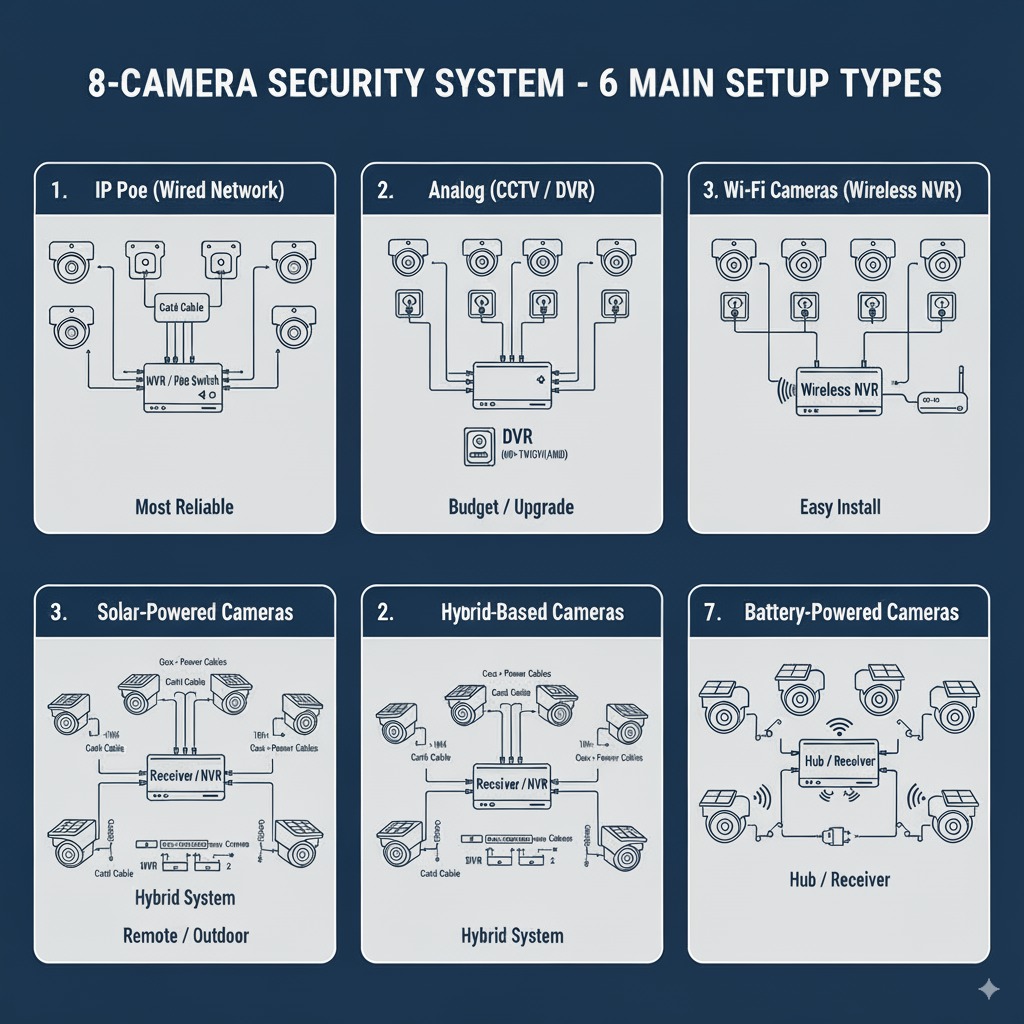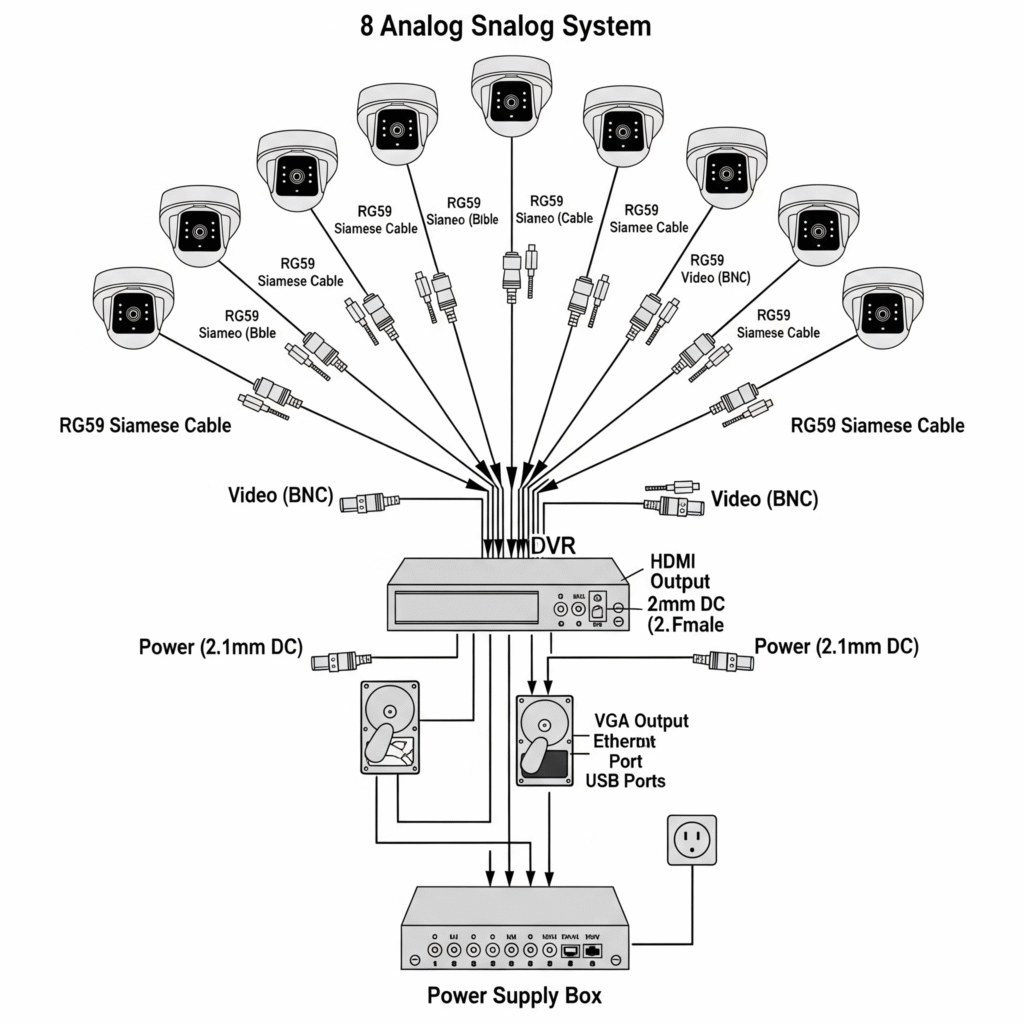Thinking about an 8-camera security setup? Great—let’s make the estimating part simple and practical. The very first thing you need to decide is where each camera will go. Placement drives everything: camera type, lens, power, cabling, storage, and ultimately your budget. For homes and businesses, common spots include indoor rooms, outdoor perimeters, driveways or parking areas, garbage or service zones, and open yards. Each of these spaces requires different hardware and mounting strategies.

I’ve been installing 3–4, 8, 16, and even 32-camera systems for clients for over seven years, and the fastest way to a clear estimate is to match locations, coverage goals, and camera specs. In this guide, we’ll first map out the typical spots for an 8-camera layout and choose the right camera style for each. Then, you’ll be ready to estimate parts, labor, and recording needs with confidence.Let’s start by understanding the types of security cameras commonly used. Then, follow the step-by-step sections below to finalize your 8-camera estimate.
8 IP Security Camera Estimate USA (IP PoE – Wired Network)
If you’re planning an 8-camera IP PoE system, this setup is one of the most reliable ways to secure your property. Each camera connects via a single Cat6 cable to your NVR or PoE switch, carrying both power and video. This eliminates the need for separate adapters and ensures a stable, high-quality feed for all cameras.

When planning an 8 IP PoE camera system, the first step is to know what devices you’ll need. Each part of the setup depends on camera placement—whether it’s indoor or outdoor—and the coverage you expect. For example, dome cameras are ideal for indoor areas like living rooms, hallways, or offices, while bullet cameras work best outdoors for driveways, backyards, or street-facing views.
Here’s a detailed breakdown of the equipment costs you can expect for an 8-camera setup:

Equipment Total: $1,910 – $3,400
IP PoE (Wired Network)
Installing an 8-camera IP PoE system requires running Cat6 cables from each camera to the NVR or PoE switch, mounting cameras, and configuring the recorder. Labor typically costs $1,200 – $2,200 depending on property size and complexity. More time is needed if walls, ceilings, or long cable runs are involved.
Total Estimate for 8 IP PoE Cameras
When you combine equipment and installation, a complete 8-camera system typically costs between $3,100 and $5,600, depending on camera specs, storage size, and labor complexity. Residential installs often lean toward the lower end, while commercial setups or higher-resolution cameras push toward the higher end.
Using an IP PoE system ensures stable, high-resolution video, fewer connection issues, and easy scalability if you ever want to add more cameras. This makes it a long-term, reliable choice for protecting your home or business.
8 Analog Security Camera Equipment Estimate

If you’re considering an analog CCTV system, the setup differs from IP PoE systems. Analog cameras connect to a DVR (Digital Video Recorder) using coaxial cables (RG59 or RG6) along with separate power lines. While generally more affordable, analog systems have lower resolution and scalability than IP cameras.
Here’s a detailed breakdown of the equipment costs for an 8-camera analog setup:

Equipment Total: $1,150 – $2,240
Installation Costs for 8 Analog Cameras
For 8 analog cameras, installation involves coaxial cable runs, power supply setup, camera mounting, and DVR configuration. Expect labor costs around $1,000 – $2,000, which can increase if the property is large or has tricky cable paths.
💰 Total Estimate for 8 Analog Cameras
When combining equipment and installation, a full 8-camera analog system typically costs between $2,150 and $4,240.
- Residential setups or lower-resolution cameras usually fall toward the lower end of this range.
- Commercial setups, longer cable runs, or higher-quality cameras push toward the higher end.
Analog systems remain a budget-friendly option, providing reliable security for homes and small businesses, especially when high-resolution IP features are not required.
8 WiFi Security Cameras (Wireless NVR) USA Estimate
A wireless NVR system with 8 WiFi security cameras is a popular choice for U.S. homeowners and small business owners who want a balance of coverage, flexibility, and easier installation compared to wired systems. These cameras connect to the NVR through WiFi, which cuts down on long cable runs, while still giving you the convenience of central recording and remote viewing.
Where This Setup Is Commonly Used
This 8 WiFi Security Cameras type of system is widely used in homes to secure areas like the front door, backyard, garage, driveway, and side entrances. Small businesses such as retail shops, offices, and cafes also rely on them to cover entrances, checkout areas, and storerooms. Because they are quick to set up, WiFi systems are also popular for rental properties, construction sites, or events where temporary security is needed.
Devices Needed and Approximate U.S. Prices

Total Equipment Cost (USA): $1,100 – $2,000 approx.
Installation Costs for 8 Wi-Fi Cameras (Wireless NVR)
Wi-Fi camera installation is faster since you don’t need network cables. Installation mainly includes mounting cameras, connecting them to the NVR or hub, configuring the app, and checking Wi-Fi coverage. Labor usually ranges from $800 – $1,500, depending on roof height, wall surfaces, and signal issues.
How Storage and Recording Work
Video footage is usually saved on the NVR’s hard drive, which can range from 2TB to 6TB depending on how long you want to keep recordings and whether you record continuously or only on motion detection. Some brands also allow optional cloud storage for an extra monthly fee, which adds a backup layer but increases ongoing costs.
Advantages
WiFi security cameras are easier to install because you don’t need to run long network cables. They are flexible, making it simple to reposition a camera if your needs change. Remote viewing on your phone is standard, and the NVR keeps all eight cameras managed in one system. For many U.S. households and small businesses, this setup is a cost-effective way to get full property coverage.
Disadvantages
Although they are called wireless each camera still needs a power connection. WiFi signals can weaken through walls or in areas with interference, sometimes leading to lag or dropped connections. If many cameras are streaming at once, the load on your network may affect performance. In addition, cloud storage usually requires a monthly subscription, and like any WiFi device, strong passwords and security updates are important to prevent hacking risks.
8 Solar-Powered Security Cameras USA Estimate
A solar-powered security camera system with 8 cameras is designed for locations where running cables or relying on continuous electricity is difficult. These cameras use built-in solar panels and rechargeable batteries, making them almost completely wire-free. They are a growing choice in the U.S. for homeowners, businesses, and remote sites that need reliable security without high installation costs.
Where This Setup Is Commonly Used
Solar-powered security cameras are especially useful in outdoor spaces where power outlets are not available. U.S. homeowners use them for backyards, driveways, farms, large properties, or vacation homes. Businesses install them in parking lots, warehouses, or temporary work sites. They are also popular for construction areas, rural properties, and cabins where electricity and internet access are limited.
Devices Needed and Approximate U.S. Prices

Total Equipment Cost (USA): $1,400 – $2,500 approx.
Installation Costs for 8 Solar-Powered Cameras
Solar-powered cameras are almost cable-free, but installation includes mounting cameras and solar panels, adjusting angles for optimal sunlight, and linking to the NVR or mobile app. Labor costs typically fall between $800 – $1,400, higher if some cameras are in hard-to-reach spots.
How Storage and Recording Work
Most solar cameras save video either on a microSD card inside the camera or in the cloud. Cloud storage usually requires a monthly fee but allows you to access video from anywhere, even if the camera is stolen. Some advanced models also connect to an NVR for centralized storage. Recording time depends on battery life, sunlight exposure, and whether you set them to record continuously or only when motion is detected.
Advantages
Solar-powered cameras are easy to install since they don’t require wiring for power or internet (if using LTE). They are eco-friendly, reduce electricity costs, and work well in remote areas. Flexible mounting makes them ideal for temporary setups, and with motion-based recording, battery life can last weeks between charges.
Disadvantages
Their performance depends heavily on sunlight availability—cloudy or shaded areas may limit charging. Each camera usually costs more than standard wired models, and cloud subscriptions can add ongoing expenses. Video quality and storage capacity are sometimes lower compared to PoE systems. Finally, for areas with weak WiFi or cellular coverage, maintaining a stable connection may be a challenge.
8 Hybrid Security Cameras System – Mix of IP, Analog, or Wi-Fi USA Estimate
A hybrid security camera system combines different camera types—such as IP (PoE), analog, and Wi-Fi—into one setup. This gives flexibility when upgrading older systems or when different areas of a property have different needs. In the U.S.A, many homeowners and businesses use hybrid systems to balance cost, coverage, and performance without replacing every existing camera.
Where This Hybrid systems Setup Is Commonly Used?
Hybrid systems are popular in homes that already have analog cameras but want to add new IP or Wi-Fi models. Businesses such as offices, retail stores, warehouses, and schools also rely on them to expand security without rewiring everything. They are especially useful when you want to mix high-resolution IP cameras for critical spots, analog cameras for basic coverage, and Wi-Fi cameras for flexible locations.
Devices Needed and Approximate U.S. Prices for 8 Hybrid Security Cameras System

Total Equipment Cost (USA): $1,500 – $2,800 approx.
Installation Costs for 8 Hybrid System (Mix of IP, Analog, Wi-Fi)
Hybrid systems are more complex because different camera types must be integrated with a hybrid DVR/NVR. Installation includes running some cables, mounting cameras, connecting Wi-Fi models, and configuring the recorder. Expect costs around $1,500 – $2,500.
How Storage and Recording Work
Storage depends on the hybrid DVR/NVR, which manages both IP and analog cameras. A large surveillance-grade hard drive (4TB–6TB) is common for recording multiple video streams. Wi-Fi cameras may also store locally on SD cards or use cloud storage as a backup. Recording can be set to continuous, scheduled, or motion-only to save storage space.
Advantages
Hybrid systems give you the best of all worlds—you can reuse existing analog cameras while adding modern IP or Wi-Fi models. This makes upgrades more affordable. They offer flexible coverage for different areas, central management through one recorder, and scalability for future needs.
Disadvantages
Since you’re mixing camera types, setup can be more complex and requires careful planning. Equipment costs may be higher because you need a hybrid DVR/NVR. Video quality will vary depending on the camera type (IP higher, analog lower). Wi-Fi cameras still depend on strong signals, and managing multiple formats may require more technical know-how.
8 Battery-Powered Security Cameras USA Estimate
A battery-powered security camera system with 8 cameras is one of the most flexible options for homeowners and small businesses in the U.S. These cameras run on rechargeable batteries and don’t require constant power or complicated wiring. They are often paired with a mobile app or hub, making them easy to install and relocate. This type of system is especially popular for users who want a simple, cable-free setup.
Where This Setup Is Commonly Used
Battery-powered cameras are widely used in residential homes for indoor monitoring, front doors, driveways, backyards, and rental properties. They are also common in small businesses such as shops, salons, and cafés where owners want a quick and wireless installation. These cameras are ideal for renters, temporary setups, or areas where running power and network cables is not possible.
Devices Needed and Approximate U.S. Prices

Total Equipment Cost (USA): $1,300 – $2,200 approx.
Ongoing Cloud Cost: $40 – $120 per month (if used).
Installation Costs for 8 Battery-Powered Cameras
Battery-powered cameras are easiest to install because no cabling is required. Installation involves mounting cameras, connecting them to the hub or app, and testing positions. Labor costs are lower, around $500 – $1,000, depending on property size and the number of cameras needing optimal positioning.
How Storage and Recording Work
Battery-powered cameras usually record to the cloud via Wi-Fi or save locally on microSD cards. Many systems offer free limited cloud storage, but extended history requires a monthly plan. Because batteries drain faster with continuous recording, most models use motion-activated recording to save both power and storage. Charging cycles depend on usage, camera resolution, and motion activity—typically lasting 2 to 6 months per charge.
Advantages
These cameras are very easy to install—no wiring, drilling, or professional setup required. They are flexible and can be moved from one location to another at any time. Great for renters, travelers, and temporary security needs. With motion recording and mobile alerts, they provide effective monitoring while saving energy.
Disadvantages
Battery life depends on usage and weather; frequent motion or extreme cold may reduce performance. You must remember to recharge or swap batteries regularly, which can be inconvenient. Cloud storage often requires ongoing fees, and Wi-Fi signal strength affects video quality. Compared to PoE or hybrid systems, they may not be ideal for large areas needing 24/7 recording.
8-camera security system in the USA
Setting up an 8-camera security system in the USA can vary widely in cost depending on the type of cameras you choose—IP, analog, Wi-Fi, solar, hybrid, cloud-based, or battery-powered. On average, homeowners and small businesses should expect to spend $1,000 to $3,500 for equipment, with extra costs for storage, installation, and subscriptions.
Each system has its strengths:
- IP cameras offer high-quality video and smart features.
- Analog systems are cost-friendly and reliable.
- Wireless and battery-powered setups are flexible and renter-friendly.
- Solar and cloud-based systems reduce wiring but add subscription costs.
- Hybrid solutions give you the best of multiple technologies.
When planning your setup, think about location, storage needs, internet availability, and long-term maintenance. Choosing the right system ensures your home or business stays protected without overspending.
